Diabetes mellitus (DM) is rapidly overburdening the health care systems worldwide. Parallel with globalization, pronounced changes in the human environment, behaviour and lifestyle have resulted in escalating rates of diabetes [1]. Globally diabetes has veiled the spread of modern lifestyle and it can be linked to an increase overweight and sedentary population [2]. The disease causes substantial morbidity, mortality and long-term complications [3]. Lipid abnormalities accompanying with atherosclerosis is the major cause of cardiovascular disease in type 2 diabetes. Moreover, DM is associated with increased oxidative stress that results in alteration of several cellular biomolecules [4].
Conventional agents are being used to control diabetes along with lifestyle management. However, these agents are not entirely effective and no one has ever been reported to have fully recovery from diabetes. Over the years, various medicinal plants and their extracts have been reported to be effective in the treatment of diabetes [5]. Generally, plants are rich sources of constituents with antidiabetic, antihyperlipedaemic and antioxidant properties such as flavonoids, gallotannins, amino acids and other related polyphenols [6]. Furthermore, medicinal plants having antihyperglycaemic activities are being more desired, owing to their lesser side-effects and low cost [7].
In literature, it is well known that date fruits and its seeds, in the form of powder, pulp and infusion, are widely used against atherosclerosis, cancer, asthenia, pulmonary diseases, and throat diseases. In addition, date fruits and seeds are used as hypoglycaemic, expectorant, tonic, aphrodisiac, mouth hygiene and antidiarrheic [14]. Moreover, the flesh of the fruit of the date palm contains very low percentage of oil compared to the seeds (0.2-0.5% vs.7.7 - 9.7% respectively). The weight of the seeds is 5.6-14.2% of the date and as such percent, the seeds represent potential sources of edible oil. Moreover, several saturated and unsaturated fatty acid are present in the flash and seeds of date [15]. Recently, it has been confirmed that date fruits (of Khalas, Sukkari and Ajwa varieties) from Saudi Arabians are a rich source of hydrophilic antioxidants due to the presence of polyphenols specifically flavanols [16]. Ironically, the date flesh is consumed since it is only the edible part while the seed is discarded and treated as waste. Actually, the date seed have high nutrients, high energy value as well as good fatty acids which are beneficial to human being [17]. Date seed oil has been reported to have unique fatty acid and tocols composition, high absorbance of UV light and other desirable physicochemical characteristics which indicate potential in the cosmetic industries [18]. Date seed extract, has protective effect against toxicity caused by carbon tetrachloride, possibly due to antioxidant’s effects of date seed that can inhibit radicals created by carbon tetrachloride [19]. In addition, one study demonstrated that date seed extract has cerebroprotective role in male rats [20]. Results from another study indicated that the aqueous and ethanolic extracts of the sukkari date fruit and, to a lesser extent, date pits, were effective in ameliorating the severity of gastric ulceration and mitigating the ethanol-induced increase in histamine and gastrin concentrations, and the decrease in mucin gastric levels [21]. Moreover, Ajwa date has been shown to have protective effect and ameliorated the lesion of Ochratoxin nepherotoxicity which might lead to kidney failure [22]. Fruits and seeds extracts of various cultivars of Phoenix diactylifera L under study exhibits very good antibacterial activity [23].
In the present study we aimed to evaluate: (i) the anti-diabetic, hypolipidaemic, and antioxidative activities; (ii) effect on liver and kidney profiles of diabetes-induced rats which treated with the most popular varieties of Saudi date seed extract (notably Ajwa and Sukkari).
Materials and Methods
Collection of Date seeds: The sukkari date is the most popular and sweetest variety in KSA, majorly cultivated in Al-Qassim Region which lies approximately at the centre of the Arabian Peninsula. Sukkari was purchased from the local date market of Buraidah. Ajwa date is majorly cultivated in Almadinah Almunwwrah; Ajwa was purchased from date market of Almadinah. Both the varieties were verified with local knowledge of the area [Table/Fig-1].
Sukkari and Ajwa dates fruits and seeds. (a) Sukkari dates. (b) Ajwa dates. (c) Sukkari date seeds. (d) Ajwa date seeds.
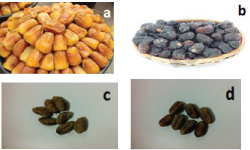
Preparation of date seed extract [3]: The fruit pulp was removed to take out the seed. Seeds were properly washed with water to remove all pulp material completely. Dried for 2-3 days at room temperature, roasted, hard seed crushed into small pieces, and then powder was made after grinding in coffee grinder. One-hundred gram of seeds powder was added to 1litre of distilled water, boiled for 10 minutes on flame. Finally on cooling it was filtered through cotton and store at 40C for use.
Phytochemical screening: The chemical profile of date seed extract has been described by various authors, and some of the main identified constituents include, flavonoids, tannins, saponins, cardiac glycosides and steroids, oleic, linoleic acid, lauric, myristic, palmitic, stearic acids. Moreover, calcium, magnesium, potassium and phosphorous contents of date seeds were found at the high concentrations [9,24–26].
Animal selection, feed and dosages: Male wistar rats (250-300g, aged between 3 to 4 months) obtained from the animal house, Research unit, college of Applied Medical Sciences, Qassim University, Saudi Arabia. All animals were housed in cages with 12/12 H light/dark cycles at 22-230C. The rats were maintained in this condition for a period of three weeks to acclimatize them prior to experimental uses. Animals were given raw chow (contained crude protein 15%, crude fat 3.50%, crude fiber 6.50% Ash 6.00% salt 0.60% Calcium 0.90% Phosphorous 0.60%, Vitamin 8.0 IU/kg, Vitamin D 2.0 IU/kg, Vitamin E 10.00 IU/Kg Energy ME Kcal/kg 2800.00, Trace minerals CO, cu, I, Fe, Mg, Mn, Se, Zn) and water ad libitum. Total 7 groups as shown in the [Table/Fig-2] were included in this study.
Groups of experimental animals.
| Serial no | Groups | Sample size |
|---|
| 1 | Normal control with water (NCWT) | 6 |
| 2 | Normal control with treatment of Ajwa seed extract(NASE) | 6 |
| 3 | Normal control with treatment of Sukkari seed extract(NSSE) | 6 |
| 4 | Diabetic control (DC) | 6 |
| 5 | Diabetic with treatment of Ajwa Seeds extract (DASE). | 6 |
| 6 | Diabetic with treatment of Sukkari seed extract (DSSE). | 6 |
| 7 | Diabetic with insulin treatments (2U/day/per rat)(DCIN) | 6 |
Dosages of respective seed extract given in quantity of 10 ml (100g/L) each rats daily. One more diabetic rats group was added and given 2 IU daily (Lantus® (insulin glargine), a long-acting human insulin analog).
Chemicals: All chemicals and reagents were used of quality grads.
Induction of diabetes: DM was induced in overnight fasted rats by freshly prepared Streptozotocin (sigma -Aldrich) a single dose of 40 mg/kg b.wt. in 0.1 M citrate blood (pH4.5) intraperitonealy. A 10% sucrose solution given immediately to avoid hypoglycaemic shock, after 3 days, glucose level was monitored. Those rats with glucose levels above 300 mg/dl in blood and urinary sugar 3+ positive were considered as diabetics then were included in the study.
Experimental design and ethical consideration: In the experiment, total 42 rats were included (18 Normal, 24 Diabetic rats). Animals were divided into 7 groups, each groups consist of six rats. Animal were handle as per standards ethical guideline of research centre.
Group I: Normal control with water (NCWT).
Group II: Normal controls with Ajwa seed extract (NASE) 10 ml/day of aqueous seed extract was given orally.
Group III: Normal controls with Sukkari seed extract (NSSE) 10 ml/day of aqueous seed extract was given orally.
Group IV: Diabetic control (DC).
Group V: Diabetic with Ajwa seed extract (DASE) 10 ml/day of aqueous seed extract was given orally.
Group VI: Diabetic with Sukkari seed extract (DSSE) 10 ml/day of aqueous seed extract was given orally.
Group VII: Diabetic with Insulin treatment (DCIN) insulin 2U/Rat once per day.
Acute oral toxicity test: Acute oral toxicity test was performed for date seed extract on the rats; two groups of rats were given date seed extracting respectively. The animals were observed for gross behavioural, neurological, autonomic and toxic effect initially for 24 hrs of dose, then whole length of study. Food consumption and body weight recorded weekly. It shows that the extract was well tolerated and the test doses safe in the experimental animals.
Blood sampling: Blood samples for glucose analysis was taken from the tail end obtained at 0,1,2,3,4,5,6,7,8 weeks and tested using Bayer’s CONTOUR® blood glucose meter. Finally at the end of 8 weeks of study, animals were sacrificed and blood sample was collected in 5ml glass tubes in plain tubes without anticoagulant for serum and EDTA for whole blood. The contents of collection tubes without anticoagulant was allowed to clot at room temperature for 30 min. Serum was separated by centrifugation at 4500 rpm on the same day and stored at -80°C until analysis.
Analytical methods
Blood Glucose estimation: Blood glucose was monitored weekly using Ascensia contour blood glucose monitoring system (Bayer Health care, Berkshire, UK) after overnight fasting by tail end puncture using sharp lancets.
Body weight analysis: Weekly body weight was taken using SOEHNLE single pan weighing machine at 0,1,2,3,4,5,6,7,8 weeks.
Serum insulin estimation: Rate insulin was analysed using ELISA kit based on the competitive binding enzyme immunoassay technique. Wuhan EIAab Science Co., Ltd.
Oxidative stress parameters estimation: Sera concentrations of superoxide dismutase estimation (Cu-Zn SOD), manoldialdehyde (MDA), and 8-hydroxy-2’ -deoxyguanosine (8-OHdG) were estimated using ELISA kit based on the competitive binding enzyme immunoassay technique. Wuhan EIAab Science Co., Ltd.
Biochemical Analysis: Lipid profile as well as liver and kidney functions parameters were performed using reagents from Human diagnostics, Germany by spectrophotometer.
Glycosylated Haemoglobin (HbA1c) Testing: HbA1c was analysed from EDTA blood, using Turbiquick analyser based on immunoturbidimetric method.
Statistical Analysis
Statistical data was carried out with the use of Microsoft Excel 2010 computer program. Results are expressed as mean±SD. Comparisons between groups were made using Student’s t-test for continuous variables. A p-value <0.05 were considered as significant.
Results
The blood glucose change in normal and diabetic rats after the treatment with date seed extracts is shown in [Table/Fig-3, 4].HbA1c and insulin levels are shown in [Table/Fig-5,6a,b] for normal and diabetic rats after the treatment with date seed extracts. The body weight changes shown in [Table/Fig-7,8a,b]. The Kidney functions parameters shown in [Table/Fig -9,10a,b] for normal and diabetic rats after treatment. Changes in liver enzymes shown in [Table/Fig-11,12]. The antioxidant parameters in normal and diabetic rats after the treatment with date seed extracts are depicted in [Table/Fig-13,14]. Serum lipid level is shown in [Table/Fig-15,16] for normal and diabetic rats after treatment.
Effect of aqueous extract of date seeds (Ajwa and Sukkari seeds) on fasting blood glucose levels (mg/dl) of normal and diabetic rats. The values were presented as mean±S.D.
| NCWT | NASE | NSSE | DCa | DASEb | DSSEc | DCINd |
|---|
| 0 Week | 83± 2.4 | 83±2.7 | 80±1.2 | 546±36.8 | 502±22.5 | 540±31.3 | 517±47.7 |
| 1 Week | 80±6.8 | 65±3.1 | 74±2.4 | 531±25.4 | 446±33.6 | 491±8.2 | 374±9.7 |
| 2 Week | 81±2.2 | 62±2.2 | 74±3.6 | 521±16.4 | 431±30.0 | 469±24.4 | 254±46.9 |
| 3 Week | 82±9.4 | 63±1.6 | 77±5.1 | 529±10.0 | 227±43.1 | 359±12.4 | 231±71.2 |
| 4 Week | 78.5±2.88 | 63±6.3 | 67±3.7 | 503±18 | 231±56.3 | 322±59.8 | 249±54.2 |
| 5 Week | 79.8±2.04 | 66±1.6 | 71±4.3 | 446±11 | 234±80.8 | 325±12.4 | 184±53.9 |
| 6 Week | 80.0±4.52 | 67±8.3 | 73±1.5 | 452±19 | 214±76.3 | 295±65.3 | 172±55.5 |
| 7 Week | 76.5±5.50 | 59±6.2 | 70±2.4 | 445±10 | 160±13.1 | 182±12.2 | 160±32.9 |
| 8 Week | 83.2±6.18 | 61±9.3 | 68±4.7 | 434±20 | 148±28.7 | 171±9.2 | 156±41.9d |
ap-value NCWT vs. DC ≤0.001, bp- value DC vs. DASE ≤0.001,
cp- value DC vs. DSSE ≤0.001, dp-value DC vs. DCIN ≤0.001.
Effect of aqueous extract of date seeds (Ajwa and Sukkari seeds) on fasting blood glucose levels (mg/dl) of normal and diabetic rats.
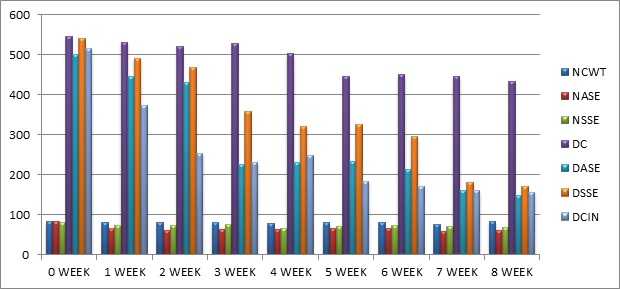
Effect of aqueous extract of date seeds (Ajwa and Sukkari seeds) on HbA1c (%) and serum insulin levels (μIU/mL) of normal and diabetic rats expressed in Mean±SD.
| S.no | Groups | Hba1C (%) | Insulin (μIU/mL) |
|---|
| 1 | NCWT | 5.2±0.19 | 2.48733±0.6 |
| 2 | NASE | 5.0±0.3 | 3.0±0.6 |
| 3 | NSSE | 5.6±0.8 | 2.0±0.4 |
| 4 | DC | 7.0±0 * | 2.0±0.3* |
| 5 | DASE | 6±0.3** | 2.94883±1.08** |
| 6 | DSSE | 6.4±0.3*** | 2.28766±0.58*** |
| 7 | DCIN | 5.9±0.6**** | 2.177±0.13**** |
*pvalue ≤0.050 NCWT VS DC
**p-value ≤0.050 DC VS DASE
***p-value ≤0.050 DC VS DSSE
****p-value ≤0.050 DC vs DCIN
Hba1c (%) and serum insulin levels (μIU/mL) of normal and diabetic rats at the end of 8 weeks. (a) Hba1c levels. (b) Serum Insulin level.

Effect of aqueous extract of date seeds (Ajwa and Sukkari seeds) on weight (gm) of normal and diabetic rats. The values were presented as mean±S.D.
| 0 Week | 1week | 2week | 3 week | 4 week | 5 week | 6 week | 7 week | 8 week |
|---|
| NCWT | 282.67±21.3 | 280±6.8 | 281±2.2 | 282±9.4 | 318.17±13.70 | 340.5±8.8 | 359.67±9.22 | 366.5±1.76 | 371.17±4.22 |
| NASE | 283±2.7 | 265±3.1 | 262±2.2 | 263±1.6 | 254±11.2 | 284±4.8 | 335±7.1 | 347±8.8 | 354±7.2 |
| NSSE | 280±1.2 | 274±2.4 | 274±3.6 | 277±5.1 | 283.17±5.6 | 337±15.7 | 359.67±9.2 | 361.33±8.3 | 363.33±11.5 |
| DC | 281±3.14 | 279±3.4 | 275±2.3 | 273±1.4 | 270±2.0 | 263±3.0 | 257.5±10 | 246±5 | 243±4 |
| DASE | 279±2.1 | 278±1.9 | 276±1.7 | 270±1.63 | 265±2.64 | 264±13.6 | 275±9.0 | 276±8.7 | 276±7.4 |
| DSSE | 280±1 | 278±1.0 | 277±1.0 | 273±1.6 | 269±1.2 | 270±4.7 | 271±4.6 | 274±4.5 | 275.±3.1 |
| DCIN | 281±3.0 | 278±3.4 | 264±9.0 | 261±6.5 | 267±5.8 | 269±1.2 | 272±1.5 | 274±1.2 | 275±1.2 |
Graphical representation of weight in different rats group in study.
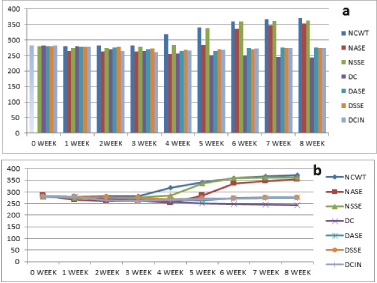
Effect of aqueous extract of date seeds (Ajwa and Sukkari seeds) on serum urea and creatinine levels (mg/dl) of normal and diabetic rats expressed in Mean±SD.
| s.no | groups | Urea mg/dl | creatinine(mg/dl) |
|---|
| 1 | NCWT | 46.7±9.0 | 0.6±.06 |
| 2 | NASE | 48.3±4.2 | 0.6±0.16 |
| 3 | NSSE | 44.2±3.1 | 0.6±0.04 |
| 4 | DC | 72.5±6.7* | 1.7±0.69* |
| 5 | DASE | 45.7±20.8** | 0.6±0.06** |
| 6 | DSSE | 52.7±7.8*** | 0.7±0.02*** |
| 7 | DCIN | 48.8±2.7**** | 0.7±0.02**** |
*pvalue ≤0.050 NCWT VS DC
**p-value ≤0.050 DC VS DASE
***p-value ≤0.050 DC VS DSSE
****p-value ≤0.050 DC vs DCIN
Serum urea and creatinine levels of normal and diabetic rats at the end of 8 weeks. (a) Serum Urea level (b) Serum creatinine.
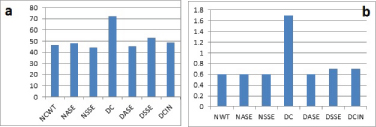
Effect of aqueous extract of date seeds (Ajwa and Sukkari seeds) on Liver enzymes of normal and diabetic rats expressed in Mean±SD.
| S.no | Groups | AST(U/L) | ALT(U/L) | ALP(U/L) |
|---|
| 1 | NCWT | 223±83.9 | 143±25.9 | 293.1±85.53 |
| 2 | NASE | 202±52.04 | 165±20.99 | 300±60.1 |
| 3 | NSSE | 245±89.67 | 165.8±20.59 | 375±90.38 |
| 4 | DC | 507±214.99* | 206.7±29.91* | 1264±299.54* |
| 5 | DASE | 200±87.88** | 142±27.5** | 465.5±158.82** |
| 6 | DSSE | 203.8±46.45*** | 147±29.67*** | 474±329.22*** |
| 7 | DCIN | 187±40.3**** | 135±26.5**** | 424±141.54**** |
*pvalue ≤0.050 NCWT VS DC
**p-value ≤0.050 DC VS DASE
***p-value ≤0.050 DC VS DSSE
****p-value ≤0.050 DC vs DCIN
Serum liver enzymes levels of normal and diabetic rats at the end of 8 weeks.

Effect of aqueous extract of date seeds (Ajwa and Sukkari seeds) on oxidative stress parameters of normal and diabetic rats expressed in Mean±SD.
| S.no | Groups | SOD(U/ML) | MDA(nmol/L) | 8OHdG(ng/mL) |
|---|
| 1 | NCWT | 4.4±1.03 | 18.9±1.39 | 35±32.5 |
| 2 | NASE | 4.1±1.12 | 19.0±1,36 | 37.7±34.18 |
| 3 | NSSE | 4.5±1.79 | 19.6±1.11 | 38.3±15.38 |
| 4 | DC | 1.2±0.66* | 20.6±0.2* | 76.7±7.53* |
| 5 | DASE | 3.6±1.21** | 18.8±1.2** | 39.9±30.23** |
| 6 | DSSE | 3.2±0.75*** | 18.6±1.59*** | 37.5±33.87*** |
| 7 | DCIN | 4.4±0.75**** | 19.0±1.31**** | 33.7±31.35**** |
*pvalue ≤0.050 NCWT VS DC
**p-value ≤0.050 DC VS DASE
***p-value ≤0.050 DC VS DSSE
****p-value ≤0.050 DC vs DCIN
Serum oxidative stress parameter levels of normal and diabetic rats at the end of 8 weeks.
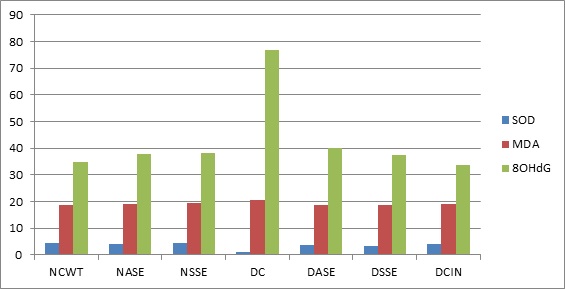
Effect of aqueous extract of date seeds (Ajwa and Sukkari seeds) on Lipid of normal and diabetic rats.
| s.no | groups | Cholesterol(mg/dl) | Triglyceride(mg/dl) |
|---|
| 1 | NCWT | 61.9±7.53 | 71.8±8.58 |
| 2 | NASE | 61.3±14.9 | 58±12.45 |
| 3 | NSSE | 62.8±10.21 | 65.7±16.29 |
| 4 | DC | 92.6±6.49 | 122±15.7 |
| 5 | DASE | 80±6.19 | 72±19.27 |
| 6 | DSSE | 72±8.6 | 81±8.9 |
| 7 | DCIN | 78±5.35 | 67.8±23.16 |
*pvalue ≤0.050 NCWT VS DC
**p-value ≤0.050 DC VS DASE
***p-value ≤0.050 DC VS DSSE
****p-value ≤0.050 DC vs DCIN
Serum cholesterol and Triglyceride levels of normal and diabetic rats at the end of 8 weeks.
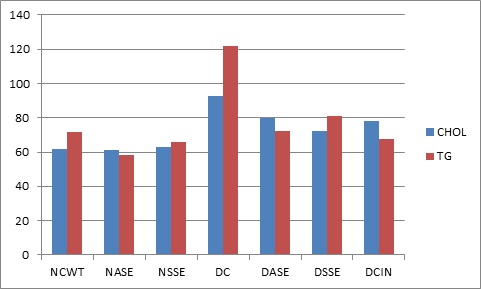
Discussion
Nowadays, scientists and researchers are very much exploring on research of natural plant products all over the world and a large number of substantiation have shown the immense potential of medicinal plants used traditionally [27]. Herbal medicines have been used since long times for the treatment of diabetes and continues to be currently accepted as an alternative therapy [28]. The active principles present in medicinal plants have been reported to possess pancreatic beta cells regenerating, insulin releasing and fighting the problem of insulin resistance [29]. KSA is among the top countries with diabetics.
Dates consumption is of course, high among people of Arabic origin, many of whom are Muslims. Dates are one of the few foods directly referred to in the Muslims’ holy book, the Qur’an (Koran). Among the 29 references to dates is advice to Mariam (Mary), during the birth of Jesus, to eat dates for her labour pains: ‘shake towards thyself the trunk of the palm-tree: it will let fall fresh ripe dates upon thee’. The Hadith (the sayings of the Holy Prophet Mohamed PBUH) contains numerous references to dates, including the protective benefits of date consumption and their use as taxes and for tithes to the poor: ‘He who eats seven dates every morning will not be affected by poison or magic on the day he eats them’ ‘From all the trees there is one tree that resembles the faithful believer. It is the date palm’ [30].
The Ajwa date fruit is one of the most popular and expensive dates, fetching 3 times the price of the next best variety. Ajwa belongs to the holy city of Almadinah Almunwwrah and its adjoining areas in Saudi Arabia. The major metabolites in Ajwa fruit were primary metabolites, sugars and proteins. Interestingly, only monosaccharide were present in Ajwa fruit, composed of isomeric mixtures of fructose and glucose, totalling about 65% of the total weight of the fruit. Because fructose was considerably higher than glucose in its total sugar content, consumption of date fruits are less harmful to persons having issues with sugar modulation, as in the case of type-2 diabetics [31]. While Sukkari which is one of the major date production from Al-Qassim region of Saudi Arabia. There are more than 6 million date palms in Qassim province alone [13].
Many researches have been conducted on date palm pulp. However, still there is limited information about the health benefit of date palm seed. Date pits, the by products of date fruit processing industries, can provide many essential nutrients and potential health benefits to the human body [32]. In recent years, interest has been increasing to extract essential oils, polyphenols and dietary fiber from date seeds [33]. In one study, it was concluded that date seed oils were resistant to thermal treatment during a long period (30–40 h) regarding the high stability of some of their quality parameters [34].
In the present study we intended to evaluate the antidiabetic, hypolipidaemic, antioxidative activities, and liver/kidney profiles of Saudi Ajwa/Sukkari date seed extracts on streptozotocin induced diabetic rats. Streptozotocin (STZ) is used as an agent to induce diabetes mellitus by selective cytotoxicity effect on pancreatic beta cells. Thus it affects endogenous insulin release and as a result increases blood glucose level [35]. The continuous administration of aqueous extract Ajwa and sukkari Saudi date seed significantly reduced the blood glucose concentration in STZ induced diabetic rats for 8 weeks [Table/Fig-4]. Moreover, it also reflects better glycaemic control and insulin level status. Data from present study showed that HbA1c level was reduced significantly while serum insulin level increased significantly among the treated group in comparison to diabetic control group [Table/Fig-6]. Previous studies conducted on diabetic rats observed the hypoglycaemic effect of date seed extract (50mg/L) along with insulin treatment to all groups and also concluded the endogenous stimulation of Insulin production [3,36]. Medicinal plants and herbal extracts have been reported to contain glycosides, flavonoids and tannins which demonstrated antidiabetic activities [20]. In addition, previous studies have shown that date seed contains all the above phytoconstituents [37]. These facts may let to conclude that the phytochemicals present in the date seed may be responsible for the observed antidiabetic activity while the extract did not produce any hypoglycaemic effect in a supported by findings from the normal rats. Hence the aqueous date seed extract may be considered to have good antihyperglycaemic active principle(s) without causing any hypoglycaemic effect unlike insulin and other synthetic drugs.
The most common lipid abnormalities in diabetics are hypertriglycaemia and hypercholesteraemia [38]. In our study, the STZ induced diabetic rats had higher levels of cholesterol and triglyceride in comparison of treated rats with date seed extract. Interestingly the cholesterol and triglyceride levels among insulin treated group (DCIN) were at par of normal control and treated group [Table/Fig-16].
Previous studies have reported that some phytocomponents, particularly saponins and steroids elicit anti-hyperlipidaemic action by inhibiting intestinal lipid absorption via resin-like action and inhibition of lipase activity [39,40]. Saponins are one of main component of date seed extract.
The elevation of serum biomarker liver enzymes such as alanine aminotransferase (ALT), aspartate aminotransferase (AST), and alkaline phosphatase (ALP) has been observed in diabetic indicating impaired liver function that may be due to hepatic damage induced by hyperglycaemia [41]. In the current study, significant elevations in markers of liver injury (ALT, AST, and ALP) reflect the hepatocytes injury in experimental diabetes [Table/Fig-12]. This result is very much similar to with the findings reported by Fatima et al., [42].
Several workers have reported a significant decrease in body weight of STZ diabetic rats [43]. The reduction in the body weight of the diabetic animals could be explained on the basis of loss of structural proteins as these structural proteins contribute to body weight [44]. Administration of date seed extract to diabetic rats caused a significant maintaining in the body weight. This could be the result of improvement in insulin secretion and glycaemic control produced by active component present in date seed extract [Table/Fig-8].
Diabetic may lead to kidney function abnormality. In this study we observed that renal function is deranged among diabetic rats while levels were less among date seed treated groups [Table/Fig-10].
Oxidative stress is found to be increased in patients with diabetes mellitus [45]. Evidence suggests that oxidative cellular injury caused by free radicals contributes to the development of diabetes [46]. Reactive oxygen species (ROS) generated in the cells is scavenged by antioxidant enzymes [47]. Moreover, diabetes also induce changes in the tissue content and activity of the antioxidant enzymes [48]. Markers of oxidative stress, such as ROS and reduced levels of antioxidants, have been found in the blood and renal tissues in both human and experimental diabetes [49]. Oxidative stress can also affect nucleic acids resulting in modified DNA bases. 8-Hydroxy-2′-deoxyguanosine (8OHDG) is a major product of DNA damage, and the measurement of its serum or urinary level provides information on various degrees of oxidative stress at the DNA level [50]. In this study serum 8OHDG is increased in diabetic rats and restoration pattern is observed among date seed extract treated groups. Oxygen free radicals react with all biological substances; however, the most susceptible ones are polyunsaturated fatty acids. Reactions with these cell membrane constituents lead to lipid peroxidation (LPO) [51]. Increased LPO impairs membrane function by decreasing membrane fluidity and changing the activity of membrane-bound enzymes and receptors [52]. In our study serum malonaldeyhde (MDA) (as an indicator of LPO) levels in diabetes control (DC) were found to be higher than those of other experimental groups [Table/Fig-14], indicating increased free radical generation in diabetic and restoring the levels with the continuous treatment with date seed extract. The primary ROS produced in the course of oxygen metabolism is superoxide which is a highly reactive, cytotoxic ROS. Superoxide is dismutated to a far less reactive product, hydrogen peroxide (H2O2), by a family of metalloenzymes known as superoxide dismutase (SOD) [53]. Phenolic compounds of fruit seeds mainly phenolic acids and flavanoids, have been shown to possess such as antioxidant, anticarcinogenic, antimicrobial, antimutagenic and anti-inflamatory activities [54]. Studies have shown antioxidant property of date seed extract majorly due to phenolic and oleic acid contents [11,55]. It is also documented that in vitro supplementation with date seed oil (DSO) can protect spermatozoa against hydrogen peroxide (H2O2)-mediated damage and can improve sperm function [56], can improve the epididymal sperm quality and could ameliorate the testicular strategy defences [57], possibly owing to antioxidant properties. In recent years, It has been well established that date seeds contain high amounts of polyphenols (50.2 mg/g), mainly epicatechin and catechin, and exert antioxidant activities in vitro and invivo [58]. Takaeidi et al., also claim that date seed extract increases serum paraoxonase and arylesterase activities. These beneficial effects may be subjected to the presence of natural antioxidants such as phenolic compounds in the date seed [59].
Limitation
We feel the limitation of small sample sizes of experimental design for more power to the statistical analysis.
Conclusion
Present study verifies the anti diabetic property, of aqueous seed extracts of two different varieties of dates namely Ajwa and Sukkari of Kingdom of Saudi on streptozotocin induced Diabetic rats. Prolong treatments with the extract restores the function of liver and kidney and balances the oxidative stress condition in diabetic treated rats.
ap-value NCWT vs. DC ≤0.001, bp- value DC vs. DASE ≤0.001,
cp- value DC vs. DSSE ≤0.001, dp-value DC vs. DCIN ≤0.001.
*pvalue ≤0.050 NCWT VS DC
**p-value ≤0.050 DC VS DASE
***p-value ≤0.050 DC VS DSSE
****p-value ≤0.050 DC vs DCIN
*pvalue ≤0.050 NCWT VS DC
**p-value ≤0.050 DC VS DASE
***p-value ≤0.050 DC VS DSSE
****p-value ≤0.050 DC vs DCIN
*pvalue ≤0.050 NCWT VS DC
**p-value ≤0.050 DC VS DASE
***p-value ≤0.050 DC VS DSSE
****p-value ≤0.050 DC vs DCIN
*pvalue ≤0.050 NCWT VS DC
**p-value ≤0.050 DC VS DASE
***p-value ≤0.050 DC VS DSSE
****p-value ≤0.050 DC vs DCIN
*pvalue ≤0.050 NCWT VS DC
**p-value ≤0.050 DC VS DASE
***p-value ≤0.050 DC VS DSSE
****p-value ≤0.050 DC vs DCIN